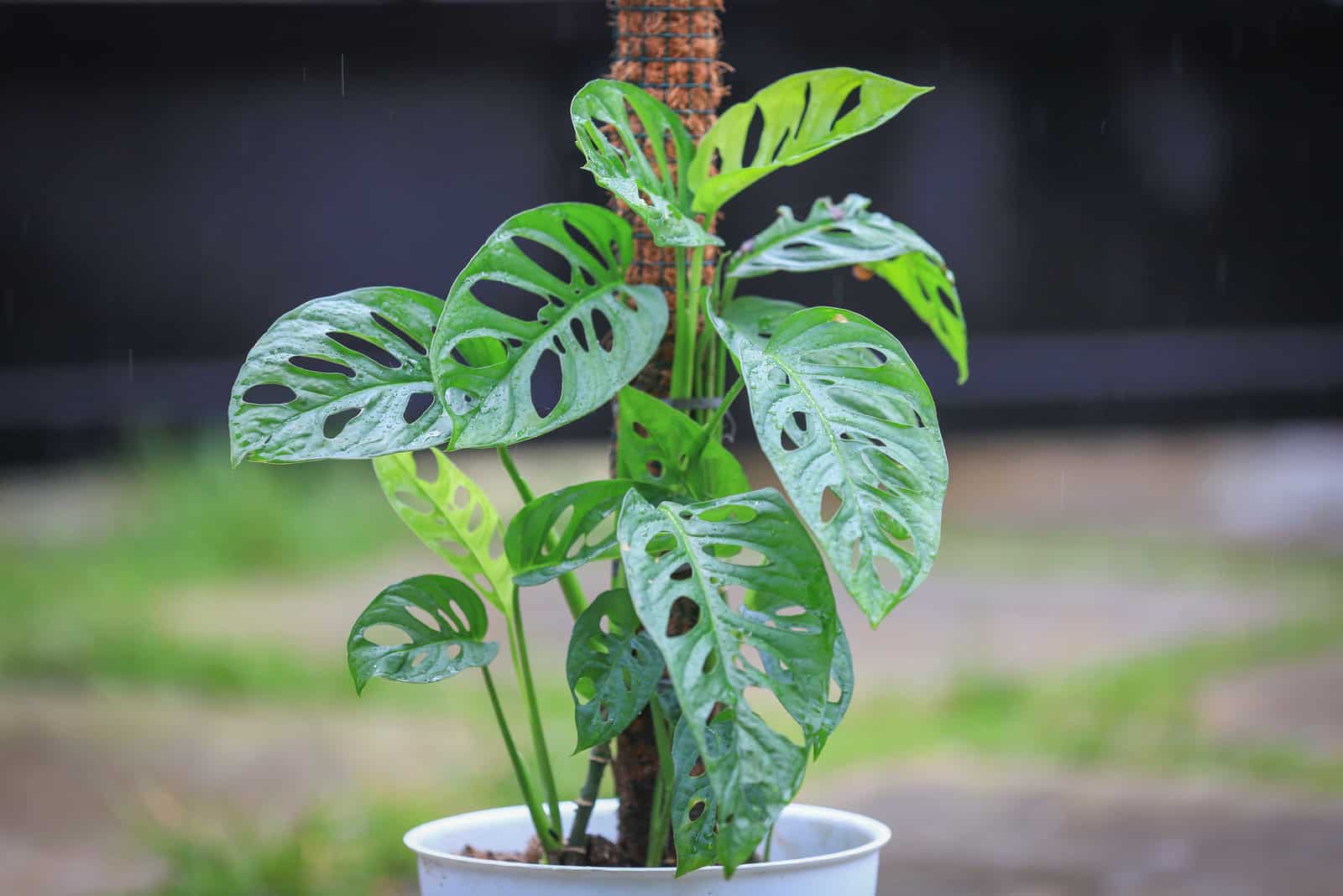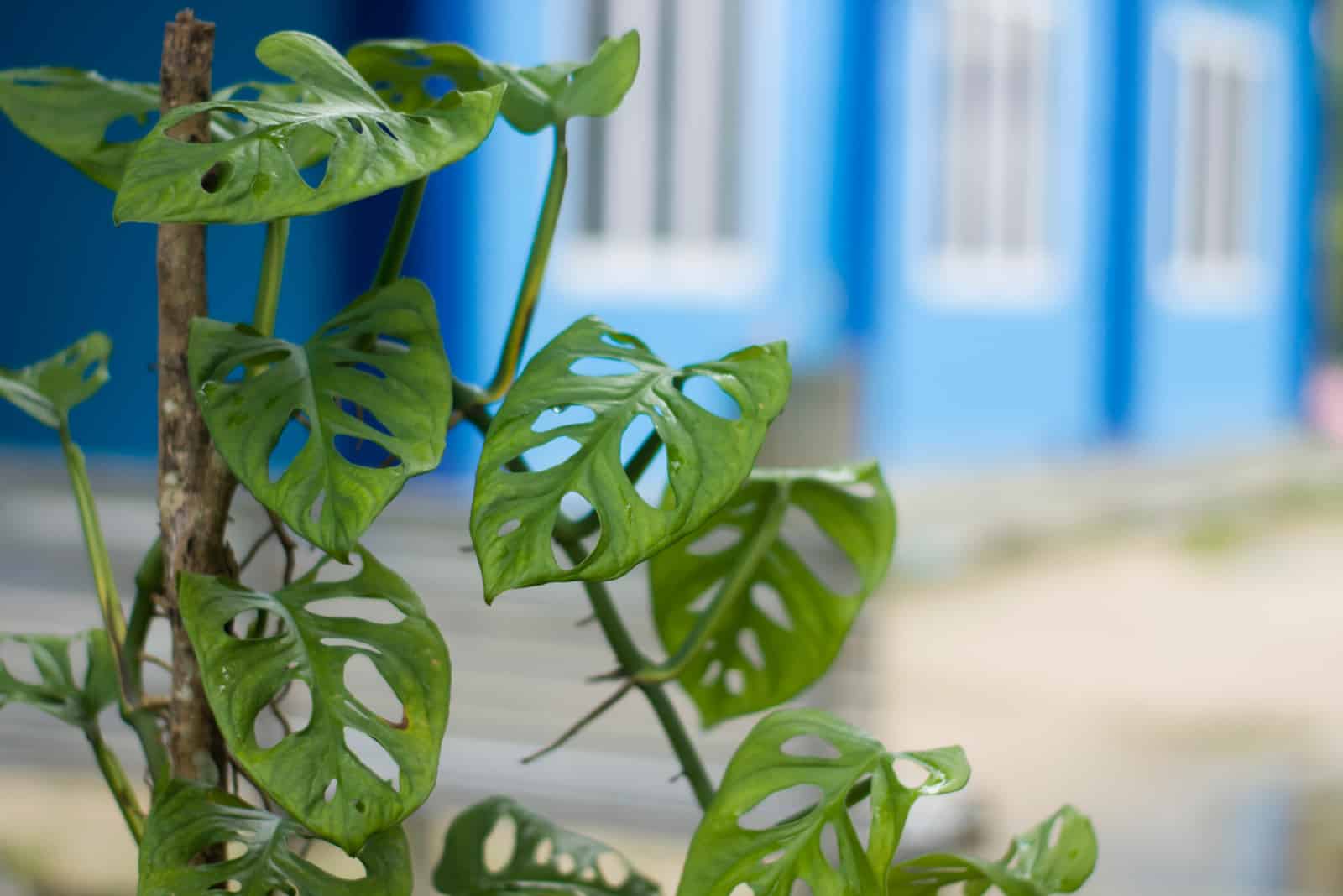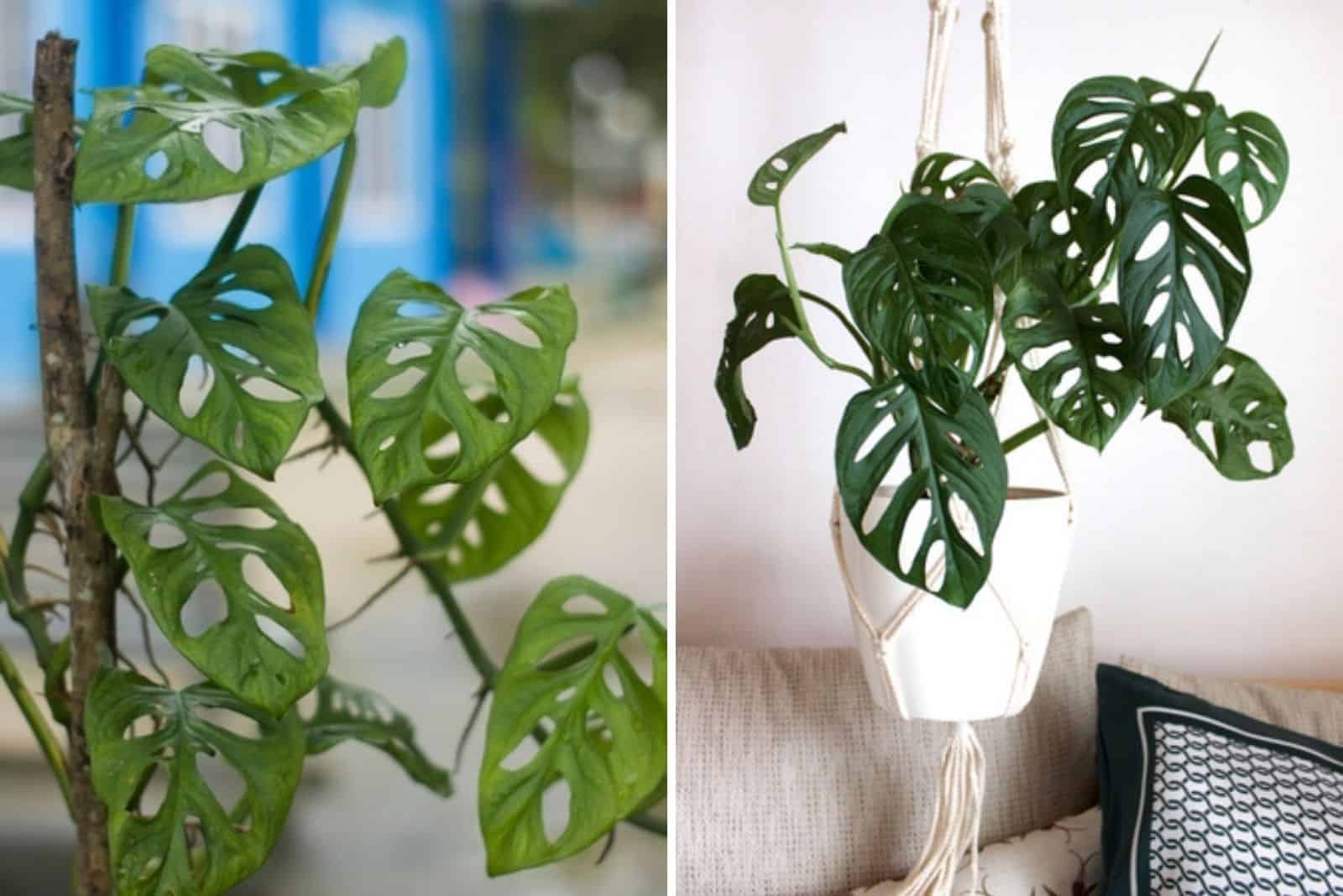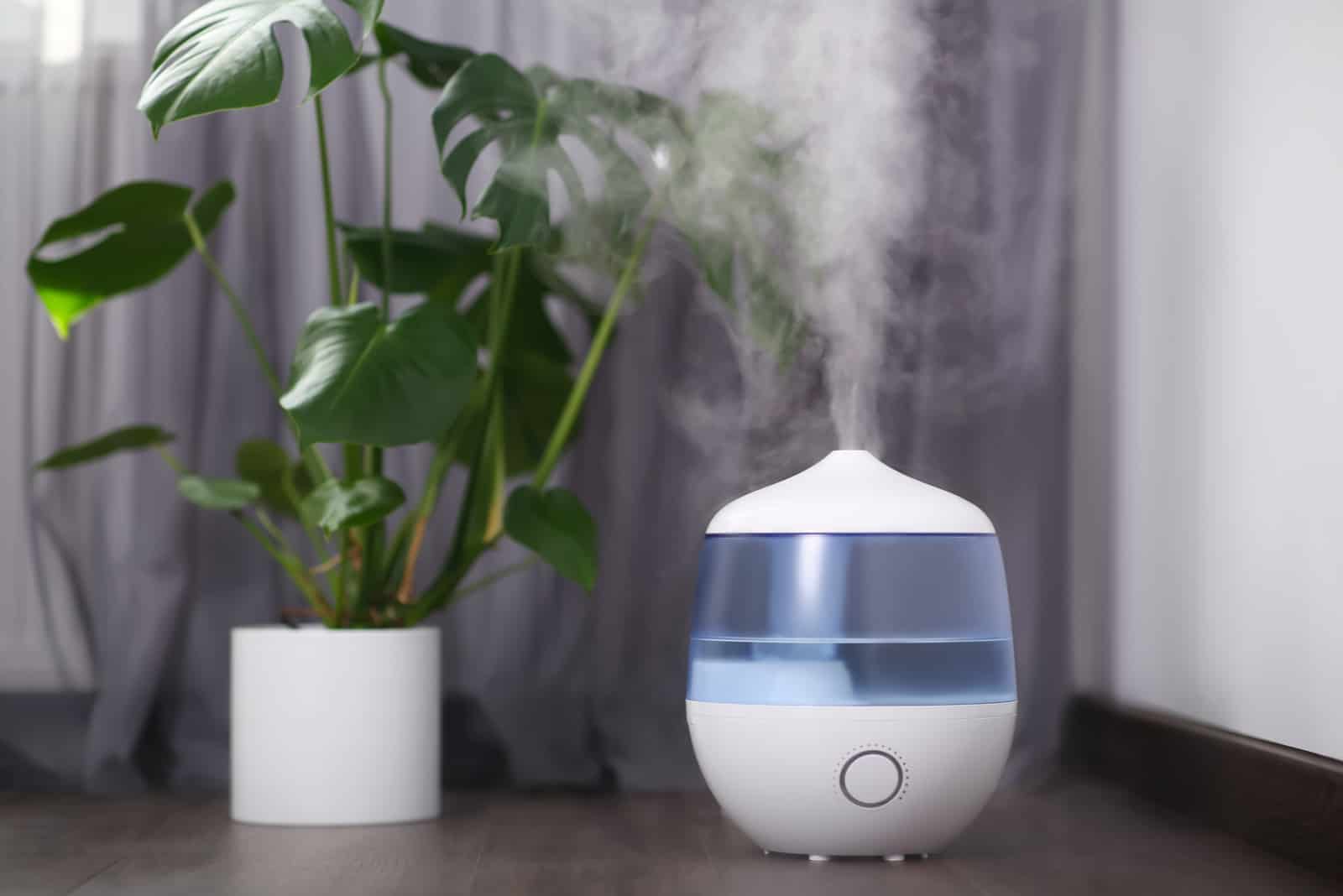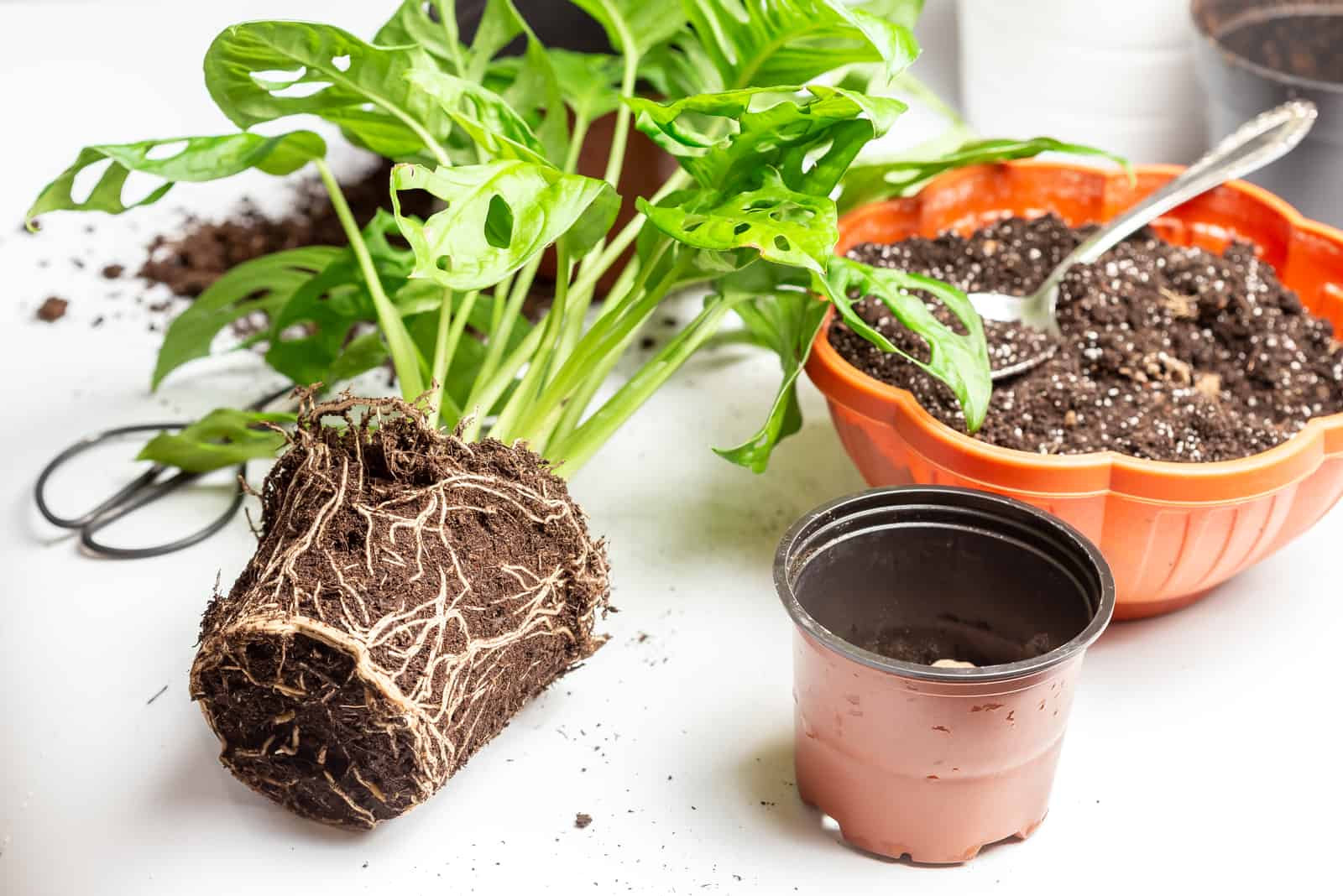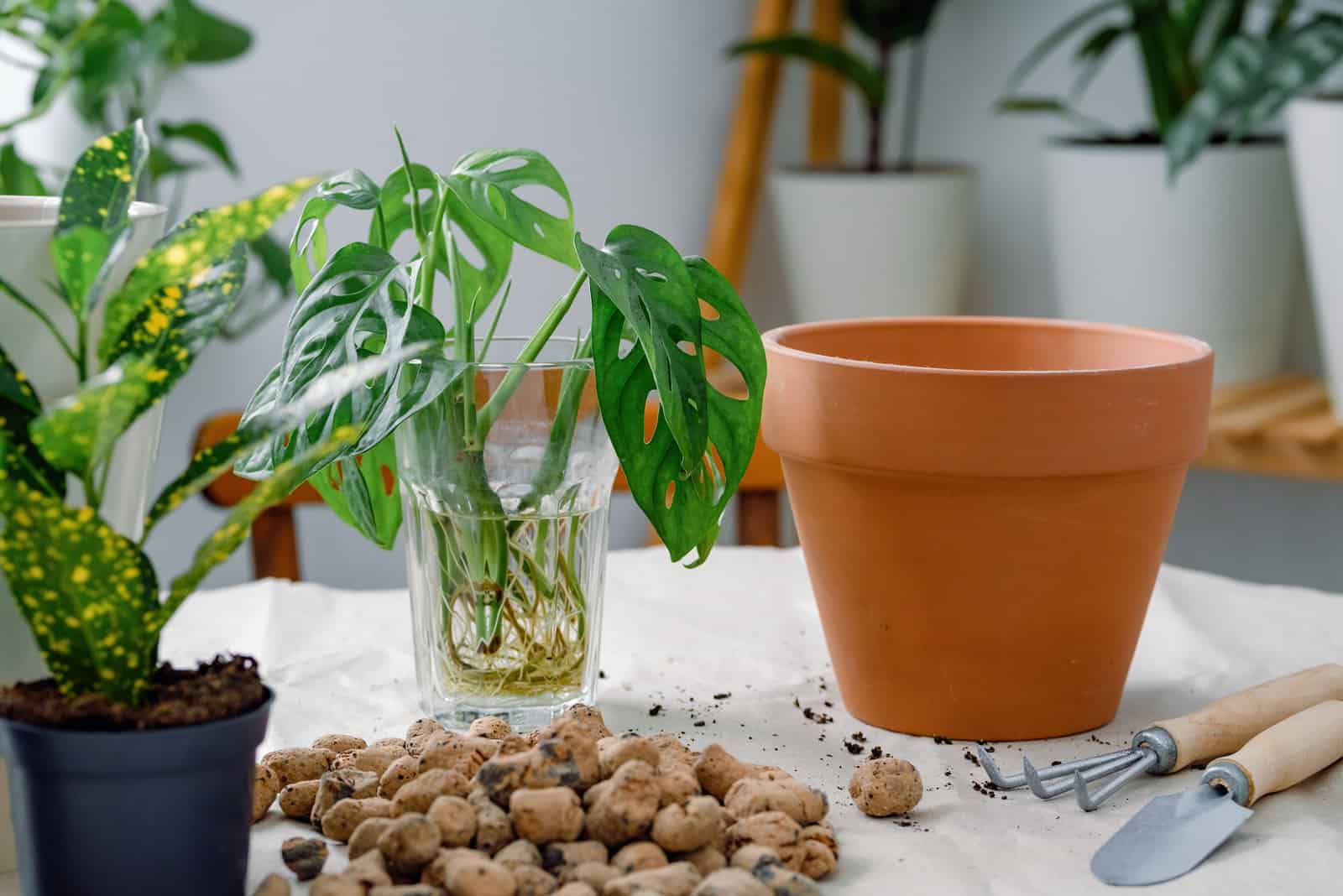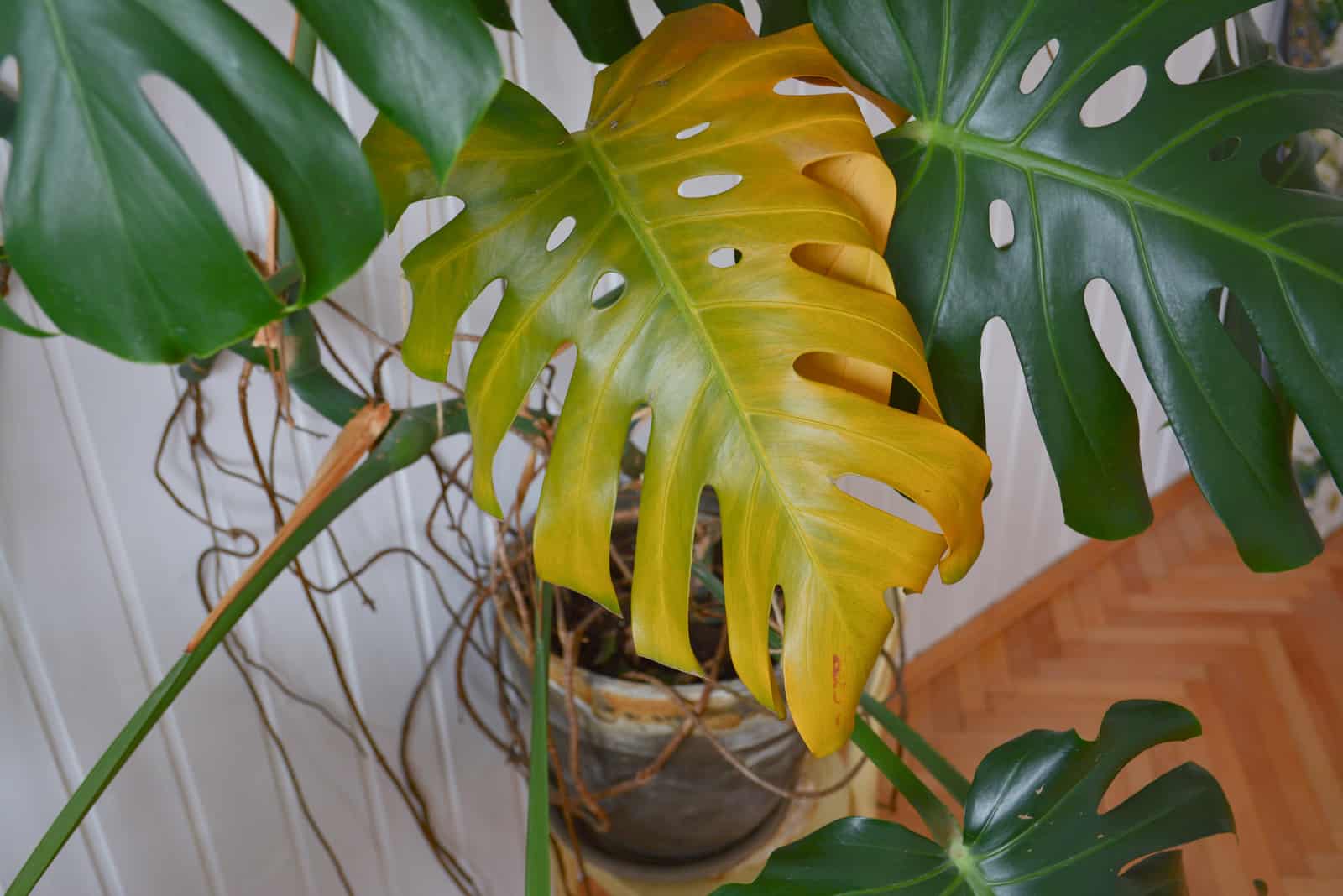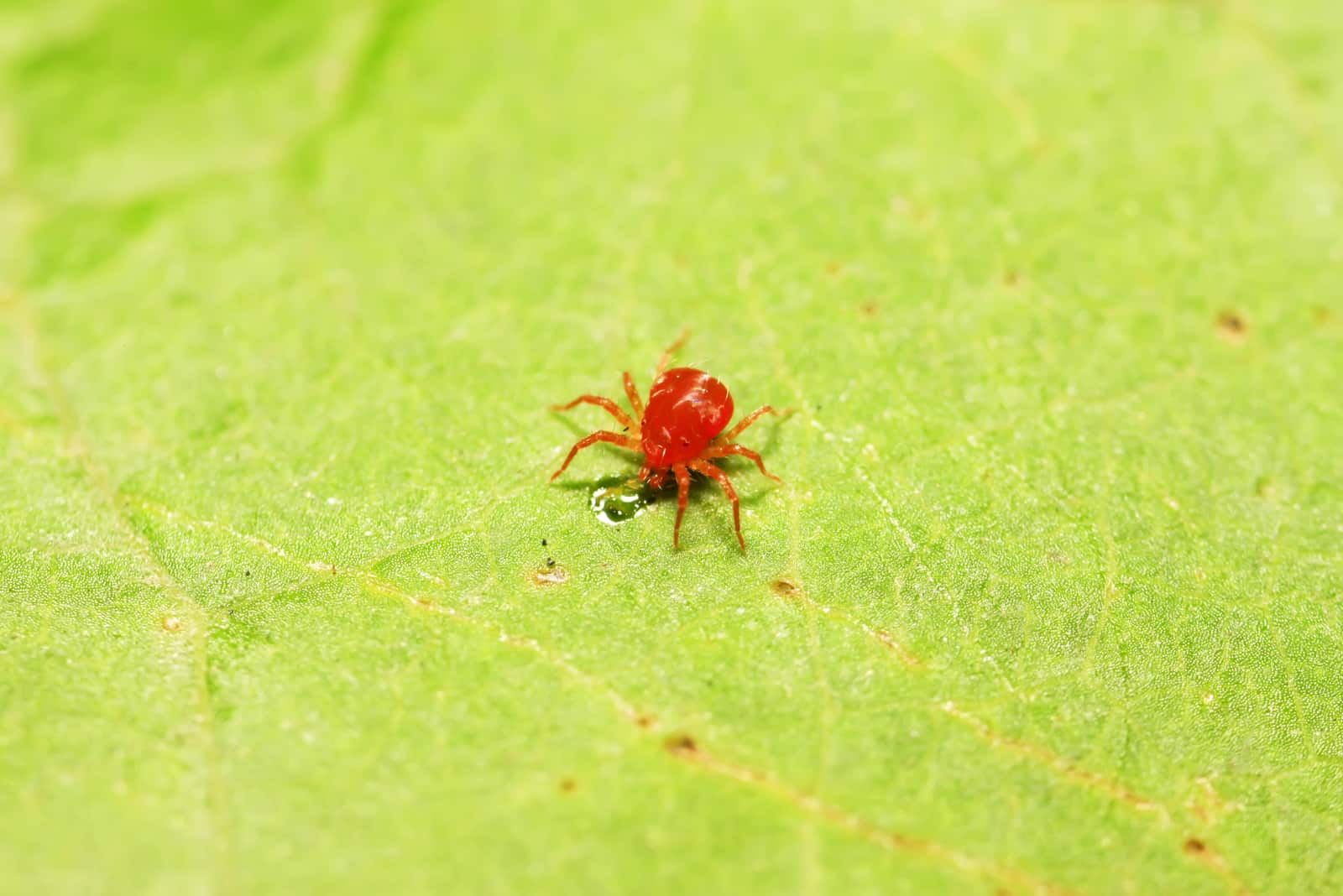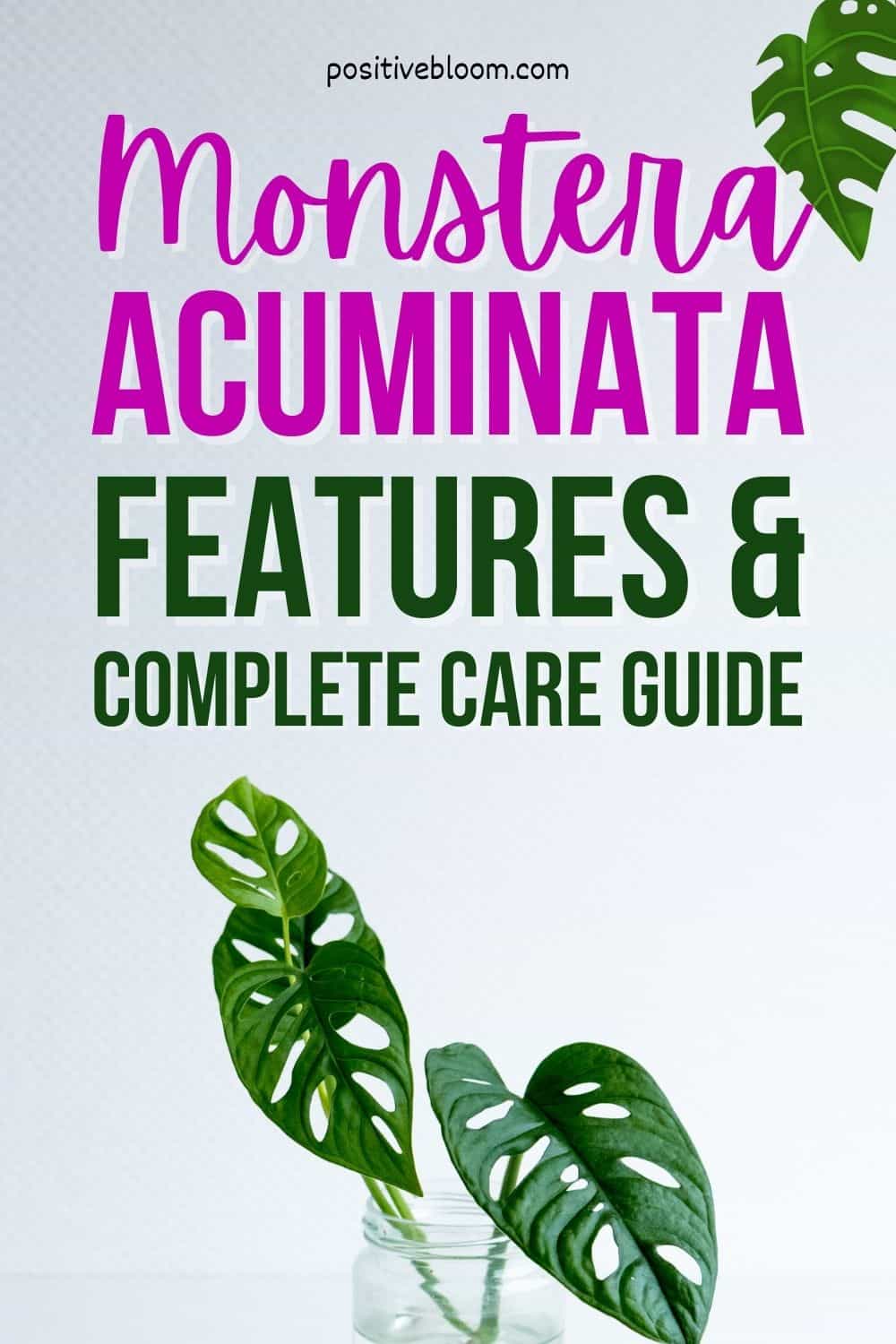I proudly present to you, Monstera acuminata!
It’s not a popular Monstera variety, but it undoubtedly still deserves a place on the ‘most beautiful house plants ever’ list; it’s small, compact, and has fenestrations. What else could we look for?
In this article, I’ll teach you how to differentiate this Monstera plant from other Monsteras which are often mistaken for this particular plant. You’ll also learn how to take care of this plant and the issues that may occur when doing so.
Before we move on, here’s some basic info:
[table id=77 /]What Does Monstera Acuminata Look Like?
You’ll first need to get to know this plant well to easily differentiate it from other plants.
Let’s discuss all the physical characteristics!
Growth Habit
This plant is a hemiepiphyte, which means that it grows horizontally on the ground in its early stages, searching for a place to climb. The plant produces thick, fast-growing stems with longer internodes during this stage. The stems are leafless and have cataphylls at the nodes.
If it’s lucky enough, it will find a place to climb and start shingling upwards, growing shingling leaves and shorter internodes.
As this Monstera grows higher, it will turn to epiphyte and have beautiful, large perforated leaves.
When this Monstera plant reaches the end of the climbing trunk, its stems will become stolons or runners, and the internodes will reach their full size.
The runners will grow horizontally until they find another place to climb. Therefore, a new Monstera plant will be formed.
A Shingle plant has a medium growth rate.
Size
Interestingly, the Monstera acuminata Guatemala plant and Monstera dubia are the longest Monsteras.
This plant can grow up to 98 feet long in its natural habitat.
When grown as a houseplant, it can grow up to 8 feet. Because of its size, this plant needs a place to climb, even if grown indoors.
Leaves
Young and mature leaves are pendant, have sharp tips, and have slightly curved midribs.
Young plants have longer leaf blades and may overlap when growing, making them look like shingles.
Mature leaves are larger and develop fenestrations. The leaf stalk shortens as the plant matures.
Here’s a video on Monstera Acuminata’s appearance:
Stems
Young stems can grow up to 6.5 feet and have long internodes.
As the plant matures, the internode shortens, and the stems become thicker.
Flowers
A Shingle plant develops yellowish inflorescence flowers, carried on a spadix.
The flowers’ spathe is greenish-white on the outside and white on the inner side. This is only possible when these Monsteras grow in their natural habitat.
The plant develops berries, and the fruiting spadix turns yellow.
Monstera Acuminata vs Monstera Adansonii
The plants are indeed similar when they aren’t placed side by side. But, let’s examine the differences.
We’ll start with the color of the leaves. Monstera acuminata’s leaves are darker, and the midrib of the leaves and Monstera adansonii have lighter-green leaves and mid-veins.
The second difference is the size of the leaves. Monstera adansonii has larger leaves that can grow up to 14 inches. In comparison, acuminata’s leaves can only grow up to 10 inches in length.
Monstera adansonii has sharp leaves, whereas the Shingle plant has broader, oval-shaped leaves. Monstera adansonii has flat leaves with many forms, such as round, wide, or narrow.
The third difference is the fenestrations’ shape and size. M.acuminata has smaller, firmer fenestrations, while the M.adansonii has larger fenestrations that are fewer in number.
These two plants also differentiate in size. M.acuminata can grow up to 98 feet in its natural habitat, and M.adansonii can grow up to 20 feet in its natural habitat and when grown as a houseplant.
How To Grow Monstera Acuminata?
Monstera plants are low-maintenance and suitable for beginners. They prefer warmer temperatures, bright indirect light, slightly higher humidity, and a soil that you can make yourself.
Let’s get into the details.
Temperature Conditions
As the plant is native to tropical climates, you must ensure a higher temperature.
It’s essential to keep the temperature between 65 to 86 degrees Fahrenheit.
Although Acuminata houseplants can grow in lower temperatures, don’t let the temperature drop below 55 °F so you can avoid any damage to the way the the Acuminata plant looks.
As the plant doesn’t withstand the cold, it will grow slower or even stop growing.
As heat increases, moisture lowers, so keep the plant away from heat sources like radiators and fireplaces.
Light Conditions
It’s essential to remember that tropical plants grow under the rainforest canopy, so they aren’t exposed to much sunlight.
Although this Monstera plant may grow in low light, I suggest using bright indirect light so the plant can grow faster and healthier. Low light may prevent leaves from developing their perforations.
You can place the plant close to an east-facing window for best results.
In this way, the plant will get some direct sunlight during sunrise (this plant needs it), which won’t harm it because it will be placed in a room with indirect light for the rest of the day.
You can also place the plant on a north-facing window. The plant will grow healthily but slower.
The only problem with the north-facing window is that the plant may not receive enough sunlight during winter. In this case, move your Monstera to a brighter place during the winter.
Consider getting an artificial light. On the other hand, if there is too much sunlight, place sheer curtains on the window.
You can always use a light meter if you are unsure about the light level in the room where you are growing this plant.
Humidity
The ideal humidity for a Shingle plant ranges from 55 to 80%.
Always check moisture levels to avoid any complications.
The plant tolerates a lower humidity, which is probably why it adapts to indoor conditions easily.
Suppose the humidity level is lower than it should be. In that case, you can increase it using a humidifier, and remember to mist the leaves a few times per week.
Provide company for the plant. Place it next to other plants.
You can increase moisture levels in the Acuminata’s pot’s soil by using a pebble tray (DIY: make your pebble tray by filling a tray with water, adding pebbles, and placing the pot over the top of the tray).
Keep your Monstera away from air conditioners and vents because they dry out the air and reduce humidity.
Mist the plant regularly. Don’t forget to mist the aerial roots, too.
Soil Requirements
Choosing the right potting soil mix is essential for Monstera acuminata plant care.
If you grow philodendrons, you can use the same potting mix for your Monstera, or you can purchase an aroid soil mix.
There is a DIY version too; mix sphagnum moss, orchid bark, or coco coir with the soil to improve drainage and ensure nutrients (30% soil, 40% orchid bark, 20% coco coir, 10% perlite).
You can also use either 50% potting soil and 50% coco fiber or a combination of 50% potting soil and 50% sphagnum moss.
You can always add extra perlite and peat moss to help your plant thrive.
The soil should be well-draining, and you can improve the drainage by using a pot with drainage holes.
The required pH level is 5.5-7.5 (alkaline pH).
Care Guide
The mature plants aren’t demanding; they require moderate watering, occasional fertilizing and pruning, and need to be repotted every 2-3 years.
Here’s a detailed description.
Watering
The best watering schedule for Acuminata indoor plant is to water only when the potting soil is dry to at least two inches down (the upper layer has to be dry).
If the Acuminatapotting soil is wet, wait until it dries to at least two inches down from the surface.
This plant despises waterlogged soil; therefore, be careful not to overwater it because this could cause root rot and yellow leaves.
To check if the plant needs water, put yoIt’singer in the soil to inspect the moisture levels.
During the summer, wait until the potting soil completely dries out to avoid accidentally overwatering.
Water the plant less during winter and fall.
Therefore, there isn’t a specific watering schedule for this plant as it depends on many factors, like humidity, temperature, light, etc.
Fertilizing
You don’t want your plant to suffer from nutrient deficiency as this may cause different issues. Therefore, feed the plant. Dilute a 20-20-20 dosage as otherwise it may cause burns on the leaves.
The best would be to use liquid plant food for fertilization’s as it is more accessible to apply due to its slow release.
The plant doesn’t need much fertilization.
You can also use a slow-release formula; start applying in spring. Always water the plant before fertilizing.
If you add higher amounts of fertilizer to the tips of the leaves, they will turn brown.
Never fertilize a Shingle plant in fall or winter as these plants go into their dormant stage. Therefore, apply fertilizer during their growing season.
Pruning
Monstera acuminata Guatemala doesn’t need much pruning, and you should only prune them when some dead or dry leaves appear.
If pruning is necessary, make sure you use shears to prevent any potential bacteria from spreading.
However, you may want to reshape your plant. Slightly trim the parts that don’t meet your aesthetic requirements.
Repotting
The best indicator that it’s time to repot, is the aerial roots. If the Acuminata’s roots poke out of the drainage holes, it’s time for repotting.
If you wonder which pot size to use when repotting, use a pot only a few inches bigger.
Larger pots need more soil; if the pots are too big, the Acuminata’s roots will have too much soil in the pot surrounding them. If there’s more soil, the moisture level will be higher which leads to root rot.
When repotting, water the Acuminata plant the day before. Take this Monstera plant out using your hands; then gently shake off the roots. Leave half of the potting soil on the roots and place the roots in fresh potting soil. Press the soil down a little bit so that you prevent air spaces.
Propagation
This Monstera plant can be propagated in many ways, but it’s impossible to propagate it without a node.
The best time to propagate this Monstera is in the early spring, although it can be propagated in summer too. If you propagate in summer, the plant may not have enough time to establish. As the plants go into the dormant stage during the winter, the propagation may not be successful.
You can propagate this Monstera from seeds, but as the seeds are hard to find, I suggest you choose one of the three methods described below.
Stem Cutting In Soil
• Place the soil in the new pot. You can make a potting mix that contains sphagnum moss and perlite, or just sphagnum moss. Water it thoroughly after you place it. If you use sphagnum moss, soak it and wring it.
• Select a healthy stem (4-6 inches). Make sure it has at least two nodes attached. Using sterilized pruners or scissors, cut below the lower node. You can purchase a disinfectant or use bleach or alcohol to disinfect the scissors or pruners.
• Remove the lower leaves and dip the cuttings in a rooting hormone (only the part that goes in the soil).
• Make a hole in the potting mix or soil and plant the two nodes in the soil. Gently tap the soil around the cutting to keep the unplanted part upright.
• Mist the cutting and cover it with a sealable plastic bag (this locks humidity and promotes rooting). Make a hole in the bag so that the cutting receives air. The bag shouldn’t cover the leaves.
• Ensure to put it in a warm place with bright indirect light.
• Make sure to check if the soil is moist; mist it if you notice that it is dry. Open the plastic bag every 4-5 days and leave it open for about 3 hours. This method will allow the plant to breathe.
You can expect the plant to root in about a month, and it will be ready for transplantation in 2 months. It can last more or less, depending on the conditions that you provide.
Stem Cutting In Water
Propagation by stem cutting in water is slightly more demanding as it will take more time, and the risk of transplant shock is higher.
However, you will be able to see how the rooting goes.
After you take the stems (the same process as shown above) and dip them in a rooting hormone, fill half of the jar with water and immerse the cutting.
Make sure you don’t dip the leaves but cover the nodes to sprout the roots.
Put the jar in bright indirect light. You should change the water in the jar every 3-4 days. If you notice that the water has evaporated, refill the jar.
The cutting will grow healthy roots in 4-6 weeks. The plant will be ready for planting, expecting new leaf growth.
Air Layering
This is a relatively easy way to propagate Monstera Acuminata. However, your plant may look ‘less beautiful’ as it has sphagnum moss around the stem. There’s a solution; rearrange the leaves.
I’m sure you’re wondering why sphagnum moss should be wrapped around the stem?! The new plant will be directly attached to the mother plant.
First, select the nodes you want to use for air layering. Apply a rooting hormone around them, and, using a sterilized, sharp knife, cut below the node. This can improve the process but can be omitted.
Take a handful of sphagnum moss and carefully wrap it around the node using a plastic bag. Secure the bag using twist ties or string and make holes (use toothpicks).
Cut the stem below the node when the roots grow about 4 inches and transplant it.
Toxicity
Monstera acuminata is toxic to humans and pets. Make sure to keep it away from them.
Also, remove any fallen leaves or those which are about to fall off.
The plant’s leaves contain needle-like and sharp crystals of calcium oxalate.
When ingested, calcium oxalate can cause health issues. Once a child or pet eats the leaves, the crystals will be released.
The most common issues that can happen after ingestion are:
• Mouth or lips swelling
• Pain and diarrhea
Common Issues
Some diseases can affect these plants, such as powdery mildew, botrytis, or southern blight.
To prevent them, wash your hands before and after doing anything with the plant.
Additionally, the Shingle plant may suffer from root rot, and different leaf changes may occur. Some pests may appear on the undersides and the surface of the leaves.
Small Leaves
This Monstera plant has large leaves; if you notice smaller leaves that aren’t growing, check the light.
Cause
Small leaves can be caused by a lack of light or nutrient deficiency. If the plant doesn’t receive enough nutrients, its growth may be stunted, and the plant will produce fewer, smaller leaves.
Solution
Give the plant enough bright, indirect light to promote the growth of its leaves.
Fertilize the plant and increase the humidity.
This is a climbing plant; ensure it has a support to climb on, such as a trellis.
Yellow Leaves
When the leaves turn yellow, you should check the soil or light.
Cause
Overwatering may cause the leaves to turn yellow. The key sign is moist soil with an unpleasant smell.
Another cause of yellowing leaves can be underwatering, and the plant may be thirsty. Again, check the soil, and if it is dry, the plant is thirsty.
Too much or too little light can also cause the leaves to turn yellow. Another possible reason is nutrient deficiency.
Solution
If the plant is overwatered, leave it to dry before watering it again. I suggest you check the roots first to determine that the plant didn’t suffer any severe damage.
If you notice dry soil, water the plant thoroughly and water more often until the plant is revived. Adjust the light or add fertilizer.
Gently remove any yellow leaves.
Brown Leaves
Check the light, temperature, humidity, and soil if the plant leaves have brown tips, edges, or brown spots. Don’t wait until the entire leaf turns brown.
Cause
High temperatures cause brown spots which look like sunburns.
High humidity may cause brown edges on the leaves.
If the plant lacks water, you will see some brownish spots.
Solution
Adjust the temperature, humidity, and light following the tips from our article. Remove the leaves that have any brownish changes.
If the soil is dry, water the plant thoroughly.
Unfortunately, some diseases may cause brown leaves, and experts should inspect the plant further.
Curling Leaves
The leaves can curl inwards and outwards and have crispy edges. Check the soil to determine the cause.
Cause
Underwatering is the most common cause of curling leaves. Too much light and high temperatures increase the need for watering.
Solution
Remove curled leaves and water the soil thoroughly. Ensure partial shade and regulate the temperature. Use a humidifier to increase humidity to reduce the need for watering.
Root Rot
If you notice yellow leaves, brown spots on the leaves, or stunted growth, always check the roots. The other sign is mushy soil with an unpleasant smell.
To determine if the plant suffers from root rot, take it out of the pot, and the roots will be mushy and black or brown.
Cause
Overwatering is the cause of root rot in most cases. Wet soil increases the susceptibility to diseases caused by pathogens, mainly fungus, which decomposes the root tissue.
Solution
After determining that a plant suffers from root rot, apply fungicide to the entire root system.
Using sterilized scissors, cut off any damaged roots (black or brown) to prevent the disease from spreading onto the healthy roots.
Wash healthy roots thoroughly and let them dry completely.
Repot the plant.
Pests
Intruder alert! As with every other houseplant, Monstera acuminata can suffer from pest infections.
These annoying, barely visible, unwanted guests may choose different parts of the leaves as their new home.
Scales and spider mites are the most likely to invade Shingle plant leaves.
You’ll notice tiny white spots that seem to web if the spider mites are the culprits.
Scales, on the other hand, look like shell bumps and leave sticky liquid on the undersides of the leaves.
Solution
There are three possible solutions that will help you to get rid of these nasty party-breakers.
1. The plant needs showering. Put the plant in the sink if it can fit, or in a bathtub, and shower the leaves.
2. If the previous step doesn’t work, use neem oil as it is a natural pesticide. Gently rub the leaves to remove pests and edges, as the spider eggs will restart the growth in the soil.
3. The third thing you can use is rubbing alcohol. Dip cotton balls in 70% rubbing alcohol and gently rub the leaves.
All the methods above will only work if the leaves don’t already suffer from severe infection.
Unfortunately, you will have to remove all infected parts of the plant. Make sure to use sterilized scissors when removing parts.
FAQs
Is a Monstera acuminata rare?
The Monstera acuminata is not a rare plant. This Monstera plant is not popular as a houseplant as many people don’t know it exists. You may not find this Monstera in every plant store that sells Monstera plants. This has nothing to do with rarity, but people just don’t search for it.
What are the differences between a Monstera acuminata and a Monstera deliciosa?
These two plants aren’t commonly mistaken. The Monstera deliciosa has larger light-green leaves and larger but fewer fenestrations.
Wrapping Up
Although uncommon, the Monstera acuminata deserves to be on your must-have plant list.
It may resemble other Monstera varieties but it deserves to be considered unique.
I suggest you grow one (use gloves when handling and keep the children and pets away).
Until next time!
Like this post? Share or pin it for later!

